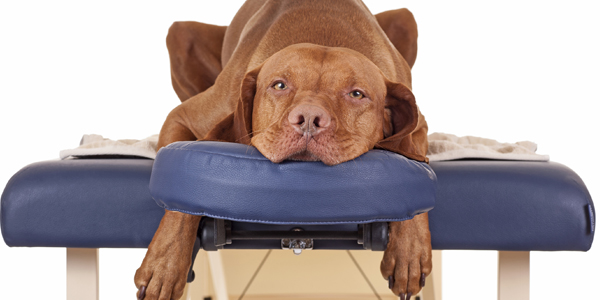This monthly column is a space for simple, useful directions, tips and information to help you keep your animals safe and happy.
Dogs have a body structure similar enough to ours that it comes as no surprise they would enjoy a massage as much as we do. Like us, they get sore feet, aching shoulders and assorted other minor pains that can be alleviated considerably if we know what we are doing.
In this segment I will be going over the basic strokes involved in performing massage on your canine friend, paying particular attention to the massage of the head and neck.
[related_content slugs=”pet-patter-saving-your-pets-life-part-three-choking,pet-patter-animal-grab-bag,pet-patter-for-the-love-of-leash” description=”More Pet Patter” position=”right”]There are professional animal massagers available who are certified and knowledgeable. I am not one of them. What I am is a gal who has done a fair bit of research followed by hands-on treatment with the various dogs under my care in my pet care business. Often, the animal senses what is happening and relaxes quite easily under my ministrations. The enjoyment is palpable! Of course, this is in no way a substitute for veterinary care, but rather a complement to it.
Before we begin a few cautionary words: Never massage an animal who is in shock, has a fever or is suffering from cancer, and avoid any areas with swelling as they will be tender to the touch.
If you are massaging a dog, it is best to walk her first, as she will expend some energy and be more receptive to staying put. Your animal may still get up and walk around between sequences, which is just fine. Simply resume the massage when she has settled back down.
Let’s review the basic strokes:
Compression
Used at the beginning and end of the massage as a warm up/cool down. For big dogs use the heel of your hand or your knuckles and for smaller dogs the tips of your fingers. Place your hand on the muscle in question, compress, and twist a little one way.
Percussion
Like the compressions stroke, can also be used as a warm-up/cool down move where you make a very loose fist and rhythmically tap along the muscle to be treated. You are not punching your dog, so stay aware of how much pressure results in enjoyment rather than annoyance. Tips of fingers and side of hand are alternatives for smaller dogs.
Cat’s Paw
A cupping motion and used to knead the tissue.
Jostling
Used mainly in neck area, lightly grip the nape of the neck and lift the skin up, release and repeat to warm up the tissue.
Palpations
Run your thumb along the area deep enough to feel for knots. Stay in tune with your animal as she will tell you with a grunt, a moan or a pointed glance when you have reached a tender spot.
Direct Pressure
Following the previous strokes, this one is applied during the treatment stage. Having found a knot and using our thumb we apply a light pressure to the area for 10 seconds, release, then apply a little more pressure for 15 seconds, release, and finally a deep pressure for 20 seconds. Your animal will tell you if you are pressing too hard.
Sweating
This stroke simply involves placing your full palm on the treatment area and leaving it there for 20 seconds. Is commonly used over the kidneys and bony part of the hip.
Begin with your animal on the floor, perhaps on her favourite blanket or in her own bed.
If she is sitting up, place your thumb and forefinger on either side of her skull just behind the ears and exert a small amount of pressure to encourage her to lie down. A treat to get her there is also permissible! After she has chewed and swallowed, with your fingers still in position, use your other hand to cup under her chin and pull her head straight out, essentially a gentle traction. Hold for 10 seconds.
Lengthen your cupping hand so you are using part of your arm to hold around your pet’s neck so you can keep her head fully supported as you work (you are standing to the side) and use your other hand to feel your way up the skull behind the ear, looking for knots or a reaction from your dog. Once you find it, apply direct pressure to the spot, using the direct pressure stroke discussed above.
Find the top of the spine, which begins in the skull and, using your thumb, run it straight and slowly down either side of the vertebrae to the tip of the tail, once with light pressure, once with moderate and a third time with deep pressure. Always stay on either side of the spine and NEVER directly on top of it.
Using the jostling stroke, lightly grip the nape/scruff of the neck and knead, feeling for knots; again, apply direct pressure.
With your thumb and using light pressure start at base of neck and run thumb straight up to top of head to release tension.
From top of head apply the compression stroke; straight down to base of neck, first light, then moderate, then deep pressure, avoiding pressure directly on the spine.
Next month I will be using these strokes to detail how to give your pet a massage for the rest of the body, including shoulders, tummy, legs and feet. Frequent massages are as beneficial for animals as they are for us; after all, we are animals, too. Let’s do all we can to keep our pets healthy, relaxed and happy.
—
Samantha Bennett lives and writes in Montreal and is the owner of the pet care business Mille Pattes. She can be reached at info@soinsmillepattes.com.
